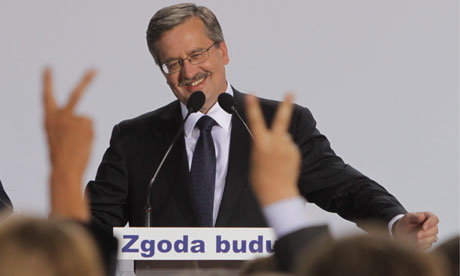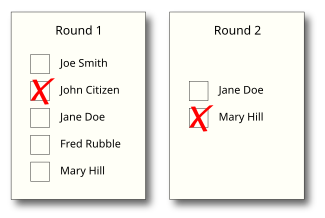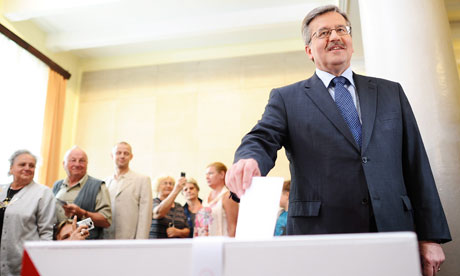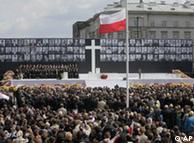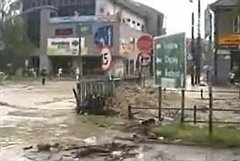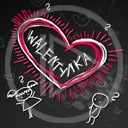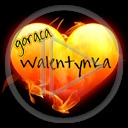
> For Poles, Katyn is a symbol of the criminal policy of the Soviet system
> against the Polish nation. In the Polish-Soviet relations in the years
> 1917-1991, Katyn is the culminating moment. The "Katyn Massacre" is a
> symbolic term, referring to one of the places of extermination of the
> Polish leading elite during the Second World War, the first to be
> discovered - the Katyn forest near Smolensk.
> The Katyn Massacre was the secret execution by the Soviets of almost
> 22,000 citizens of the Polish state who - after the Red Army entered Poland
> on 17 September 1939 - were taken prisoner or arrested. Pursuant to a
> secret decision of the Politburo of the Central Committee of the Communist
> Party of the Soviet Union (Bolsheviks) of 5 March 1940, approximately
> 15,000 POWs, previously held in special NKVD camps in Kozelsk, Ostashkov
> and Starobilsk, and 7,000 persons interned in prisons of the western
> district of the Ukrainian and Belarusian republic, i.e. the eastern
> territories of Poland included into the Soviet Union in 1939, were killed
> with a shot in the back of the head.
>> The victims were mainly important citizens of the Polish state: officers
> of the Polish Army and the Police, officials of the state administration,
> and representatives of intellectual and cultural elites in Poland. They
> were buried anonymously in mass graves, in at least five places within the
> territory of the Soviet Union. In April-May 1940, POWs from three special
> NKVD camps were transported by trains to the places of execution: Katyn
> (from the Kozelsk camp), Kalinin (from the Ostashkov camp), from Kharkiv
> (Starobilsk camp). Those killed in Kalinin (currently Tver) were buried in
> Mednoye. Others, held in prisons and murdered there, were buried in
> previously undetermined places; two are known: in the Belarusian Republic
> and the Ukrainian Republic of the USSR (Kuropaty near Minsk and Bykivnia
> near Kiev).
>> After the outbreak of the German-Soviet war and the Polish
> Government-in-Exile initiating official relations with the Government of
> the Soviet Union in the summer of 1941, the Soviet authorities failed to
> provide Poles - despite their efforts - with any information concerning
> those "missing in action". The Soviet Union broke the alliance in April
> 1943, when the German Army stationed in the Smolensk region discovered a
> burial ground in the Katyn Forest and attacked the Soviet Union for
> propaganda purposes. Soviet authorities responded with the tactic of
> pinning the blame on the Germans who had allegedly murdered Poles after
> entering those territories in 1941. Stalin, using the pretext of "slander
> against the USSR", broke relations with the Polish Government-in-Exile (in
> London).
>> The "Katyn" case was one the best guarded secrets of the Kremlin during
> the entire USSR period. When, after the end of the Second World War, during
> the Nuremberg Trials, the Soviet Union failed to pin the blame for the
> massacre on the Germans (but at the same time managed to avoid being judged
> for its deeds), the Soviet authorities permanently adopted the
> interpretation of the "Katyn lie", in defiance of the facts: the Soviets
> had nothing to do with the massacre of Polish officers - German fascism is
> responsible for everything...
> The Katyn Massacre was not an isolated event. It was the consequence of
> system differences, the Soviet attempt at creating a state of the world
> proletariat, and the growing hostility between the Soviet Russia and the
> pre-war Poland. When, after the end of the Polish-Bolshevik war in 1920,
> which was victorious for Poland, the Soviets had to give up the export of
> the revolution to the West for many years, and Stalin himself was
> criticised for his significant mistakes on the Polish front - the Soviet
> authorities accepted their Western neighbour to be their main enemy. During
> the Great Terror in the USSR in the years 1937-1938, which was aimed at
> pacifying the anti-Bolshevik mutiny brewing in the whole of Russia, the
> Soviets fought Polish groups in their territories with extreme fierceness.
> Over 70,000 Poles (Soviet citizens) were killed with a shot to the back of
> the head at that time. One in every ten victims of the Great Terror was
> related to Poland. The mechanism of mass exterminations was fine-tuned in
> the USSR then.
> When in September 1939 Stalin, after entering into an alliance with
> Hitler, attacked Poland defending itself against the Germans, one of his
> aims was to permanently destroy the Polish statehood. From the very first
> moments of that aggression, the Soviets consistently isolated (or killed on
> the spot) those people whom they regarded to be representatives of the
> group of leaders of the state that was being destroyed, and particularly
> the officers. One might imagine that the Soviet authorities planned their
> systemic elimination in advance - just as it was planned by the Nazis in
> "their" part of the occupied Poland. With regard to those prisoners the
> Soviet did not apply the rules of international law, that is why they held
> on to the lie they devised with such consistency.
> After the relations with Poland were severed in 1943, and after the Soviet
> Union took control of Poland's territory in the years 1944-1945, it
> controlled the subjugated country, ruled by puppet governments subordinated
> to the communist empire, well into the eighties. During that period, the
> demands for the truth about "Katyn" were treated as an act hostile not only
> against the USSR but also the People's Republic of Poland. This is because
> the post-war Poland was harnessed to the "Katyn lie".
> After the system changes in the entire Soviet bloc (1989-1991), the demand
> for the explanation of the truth about "Katyn" also appeared on the Russian
> side. Many Russians helped in discovering the truth about that crime. In
> the years 1990-1992 the main "Katyn" documents were disclosed, including
> the decision of the Politburo of the Central Committee of the Communist
> Party of the Soviet Union (b) of 5 March 1940, signed among others by
> Stalin. In August 1993, a group of Russian historians developed an
> exhaustive expert appraisal in Moscow, presenting honestly the process of
> the crime and the subsequent lies.
> Those guilty of this crime have never been judged. Although the people who
> made the decision are known, as are over one hundred executioners (the list
> of persons rewarded for the "camp clearing" campaign was disclosed).
> However, the investigation on the Russian side was discontinued, and the
> Russian authorities refuse to make any comments on this subject. No one has
> been and no one will be punished for the crime.
> There is a material trace of the crime. Three cemeteries built by the
> Poles - in Katyn, Mednoye and Kharkiv - where each and every one from among
> almost 15,000 Polish POWs is commemorated by name. This is an exception
> among the graveyards remaining after the crimes of the Soviet power.




